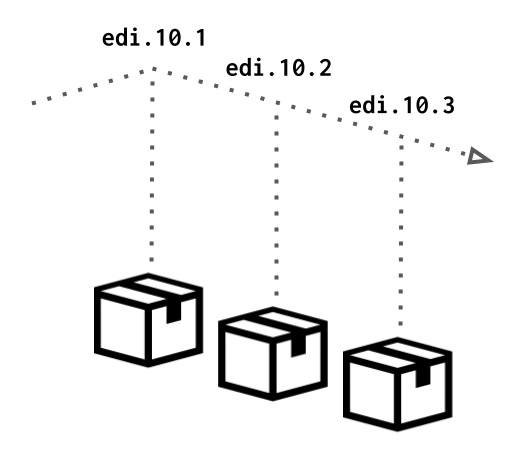The Data Package
The data package is the unit of publication within the EDI Data Repository. It's an assemblage of science metadata, one or more science data objects (including scripts, documents, images etc.), a package quality report, and manifest of contents. Each data package is assigned a Digital Object Identifier (DOI) and published in the repository for future use.

Features of a data package
Data packages have some important features. First, they're immutable which makes them suitable for reproducible research. Second, data packages are versionable thereby accommodating updates and improvements through time. Finally, data packages are citable through globally unique and persistent DOIs.
Example data package
Here's an example of what a data package looks like once published in the EDI Repository.
What to include in a data package
When publishing data in support of a manuscript, include the data required to reproduce the results. Consider publishing this data in a minimally processed form, so it can be reused in other contexts. To make results reproducible, include any scripts used in processing and analyzing the data. Be sure to include links to any external source data used in a data package with provenance metadata. Also, consider adding documents that provide additional metadata detail (e.g. pdf of protocols).
For further information on optimizing a data package for reuse see designing a data package.
Identifiers of a data package
Digital Object Identifier (DOI)
The DOI is a globally unique and persistent identifier that unambiguously resolves to the data package landing page. DOIs are used in citations and references of a data package.
Example DOI: doi:10.6073/pasta/0cd8caf2eb9959c98b335828628914fb
Data package identifier
The data package identifier is used exclusively within the EDI Data Repository to associate the components of a data package. A data package identifier has the form scope.accession.version, where:
- scope is a string value that identifies the organization, project, or theme of the data package
- accession is an integer value that uniquely identifies the data package in the namespace of the scope
- version is an integer value in increasing order that identifies the version of the data package
Example data package identifier: edi.1072.1
Data object identifier
Individual data objects within a data package can be referenced and downloaded using the corresponding data object identifier. This value is hyperlinked to each data object listed under the Download Data section of the data package landing page and listed under the Data Entity section of the data package full metadata page.
Example data object identifier: https://portal.edirepository.org/nis/dataviewer?packageid=edi.1100.1&entityid=63bea300d6a56a7f88986f0262ae5e74
Versioning data packages
The EDI Data Repository enforces strong versioning (i.e. published data and metadata are immutable). Each revision of a data package is published under a new version number with each revision receiving a new DOI.

In the example above edi.10.1 is superseded by edi.10.2, which in turn is superseded by edi.10.3. Each version in this series is accessible under the data package landing page previous revision link, but only the newest version is returned when searching. If browsing a superseded version, the landing page will highlight that "This data package is not the most recent revision of a series".
See the page on Updating a Data Package for more on this topic.